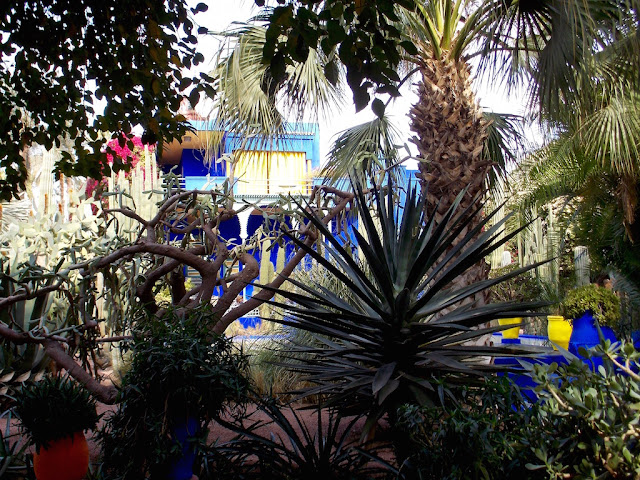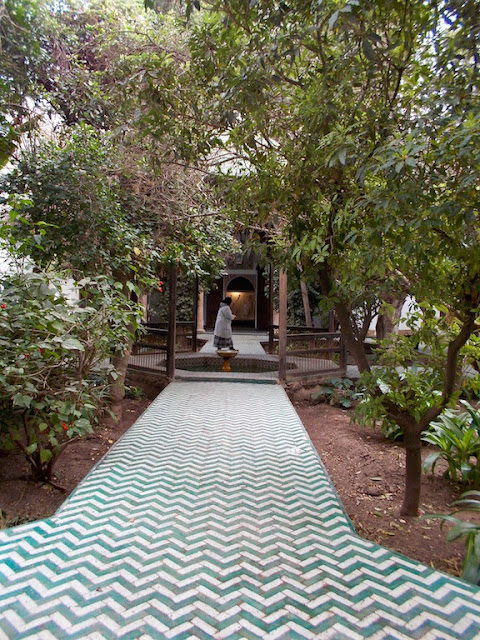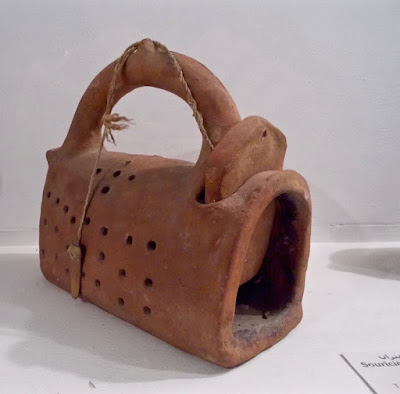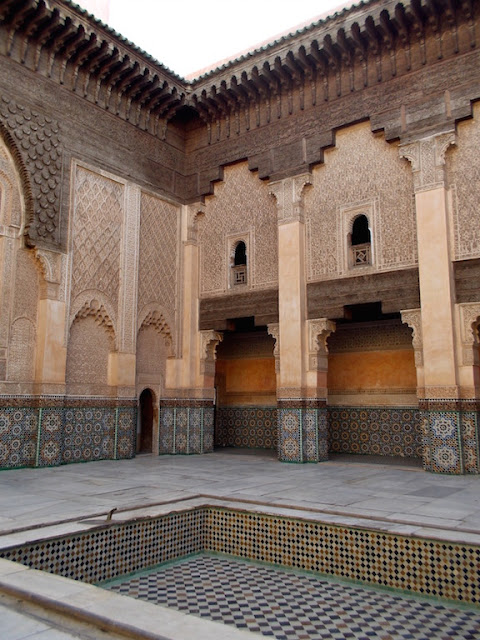After an uneventful flight with Vueling, Spain's answer to Ryanair, we ended up trailing around the Marrakesh airport as other passengers dispersed. We were looking for a taxi driver with my name on a card, but could not find him. After some back and forth on the phone with our riad (B and B) owner, he turned up with a barely legible sign. Where he'd been for half an hour, who knows?
He drove us to the gates of the medina where our bags were transferred into a barrow and wheeled through winding alleys to our accommodation. The barrows seemed to be one of the main methods of transporting goods through the car-free (but sadly not motorbike free!) streets.
Our riad, like most other residences in the medina, presented only an anonymous door to the outside world.
Inside, however, was a bright atrium, decorated with trailing vines, local rugs and cushions.
This is where we had breakfast every morning.
Our room was on the upper floor, reached by an internal balcony. Above that was a roof garden where we spent part of each day enjoying the sunshine and the views.

We were also able to peek down into the adjoining house and catch glimpses of daily life including the care of a goat stabled on the lower level.
On our first day, our charming host Hassan led us from his house through the souks to Djmaa El Fna , the central square of the city that locals refer to simply as La Place. Although our route snaked through numerous narrow alleys with many left and right turns, we quickly came to recognize the landmarks - a mosque here, a certain blue door there - that guided us to and fro. It also helped that Michael carried a small compass.
The streets were full of interesting sights: patient donkeys and mules
... and not so patient ones,
... sellers of herbs, especially fresh mint for the sweet tea so much a staple of this alcohol-free country
... sellers of oranges and strawberries
... sellers of vegetables, not to mention brooms.
... and various other interesting sights.
La Place was dominated at one end by the minaret of its mosque, the only structure in the city permitted to be taller than a palm tree. Horse and carriage rides were available at its base.
By day this vast square was filled with people peddling various goods, playing music, decorating hands with henna and juggling. We looked for snake charmers but didn't see any; perhaps they only appear in warmer months.
By night these people disappeared, replaced by stalls selling all kinds of interesting food.
This was our favourite among many, serving delicious couscous and tagines:
As we sat at one of its long, plastic-covered tables, we could watch the cook at another stall across the way barbecuing great hunks of meat.
At the end of the evening, all these stalls are packed up and wheeled away, leaving the square free for the daytime souvenir sellers.
Rabba K'dima, another substantial square just outside the souks, specialized in spices
... carpets
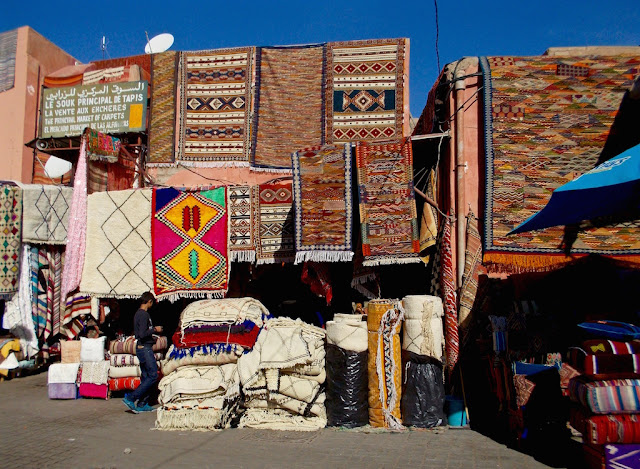
... and hats
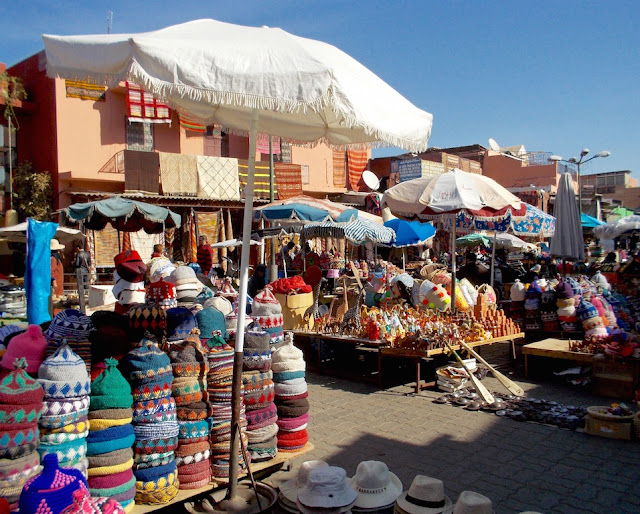
Yet another square had a thriving vegetable market.
Unfortunately, none of my photos inside the souks turned out, thanks partly to the low light and partly to my concerns about respecting people's right to privacy.
However, there were other highlights that Marrakesh offered. A particularly enjoyable one was a visit to Jardin Majorelle in the "ville nouvelle" outside the medina. The house and garden were owned and developed over a couple of decades by Yves St. Laurent and his partner Pierre Bergé. The intense colours, particularly the famous "Majorelle blue", contrasted with the quiet greens and greys of cacti, palms and succulents.

There were
quite a lot of visitors in the garden, but they seemed to be clustered mainly around the house with its adjoining
museum and shop. Elsewhere I was able to take
photos that make it appear deserted. In holiday periods or more popular months for travel in Morocco, that would probably be way more difficult.

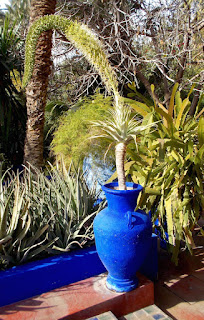

On the edge of this pond, I discovered a tiny brown frog, framed by reflections of palm fronds.
Another spectacular site was the Bahia Palace within the medina. It was quite a long, hot walk to get there, but worth it when we finally found the gate, which led into a cool and shady avenue.
At the other end was the magnificently decorated palace.
The wooden ceilings were painted with painstaking detail.

Some of the walls had equally elaborate tile and filigree work, particularly around this fireplace.
Elsewhere the details seemed more modest and representational.
Not far away was Dar Si Said, a former riad but now a museum showcasing the work of Moroccan artisans.
In the dim entry, this picturesque old map of the city and surroundings was hard to photograph, especially with the reflection in the glass of the single bright light.
A heavily ornamented wedding chamber was the most elaborate feature,

... but I thought the simple and peaceful green courtyard with its herringbone tiles was also attractive.
Among displays of luxurious fabrics, jewellery and daggers, this innovative mousetrap was a standout.
Another significant site was the Ben Youssef mosque, a vast green-tiled building which we, as non-Muslims, were not permitted to enter.
We could, however, visit the nearby Ben Youssef madrassah (religious school) which in its heyday housed 900 students.
The central courtyard was very grand, but the accommodation much less so. A few rooms had small arched windows overlooking the courtyard,
... but most were dark cells with virtually no natural light. Since there were nowhere near 900 of them, we assumed that the students were packed like cordwood several to a cell.
After four days in Marrakesh we felt we had sampled the best of it. The noise and constant hustle on the main streets was sometimes a challenge and we were grateful for the opportunity to retreat to the quiet of our riad. On the fifth day we boarded a bus for the three-hour journey to the Atlantic coast and the fishing town of Essaouira.

























